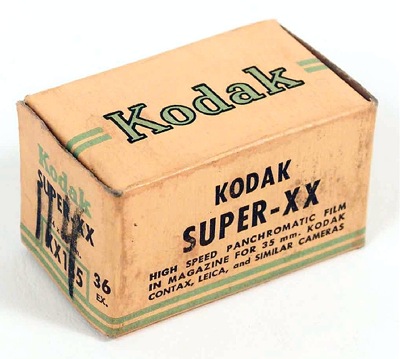 [Back in August of 2021 Patrick Peccatte introduced me, via email, to Philippe Villéger. Villéger is a member of the informal collective devoted to annotating the historic WWII images of Normandy posted online at PhotosNormandie, another internet project to which Peccatte contributes. (For more about Peccatte, Villéger, and the PhotosNormandie project, see the details at the end of this post.)
[Back in August of 2021 Patrick Peccatte introduced me, via email, to Philippe Villéger. Villéger is a member of the informal collective devoted to annotating the historic WWII images of Normandy posted online at PhotosNormandie, another internet project to which Peccatte contributes. (For more about Peccatte, Villéger, and the PhotosNormandie project, see the details at the end of this post.)
Villéger raised an intriguing possibility: Given the correlation that military historian Charles Herrick and I established between Capa’s Omaha Beach images and color film footage shot by U.S. Coast Guard cinematographer David T. Ruley from a different position and angle but at roughly the same time, could Ruley have actually recorded the arrival on the Easy Red sector of the very same Higgins boat that brought Capa in?
I found this a reasonable and indeed logical question, yet one that had not occurred to me. In the end, Peccatte penned a distillation of Villéger’s arguments, while also taking into account evidence developed previously by Charles Herrick and myself. This has resulted in an article summarizing that hypothesis. Peccatte published this first, in French, at his blog on December 20, 2021. The English translation — achieved by me — will appear here in three installments. You’ll find Part 2 below; click here for Part 1, and here for Part 3. — A.D.C.]
•
Could Robert Capa have been filmed while photographing the Normandy landings? (b)
by Patrick Peccatte
•
Complementary sources
… Three sources therefore complement each other. The first five photos of Capa, the sequence filmed by Ruley, and the photos of Gislason can all be compared. [See Part 1 for these visual documents. — A.D.C.]
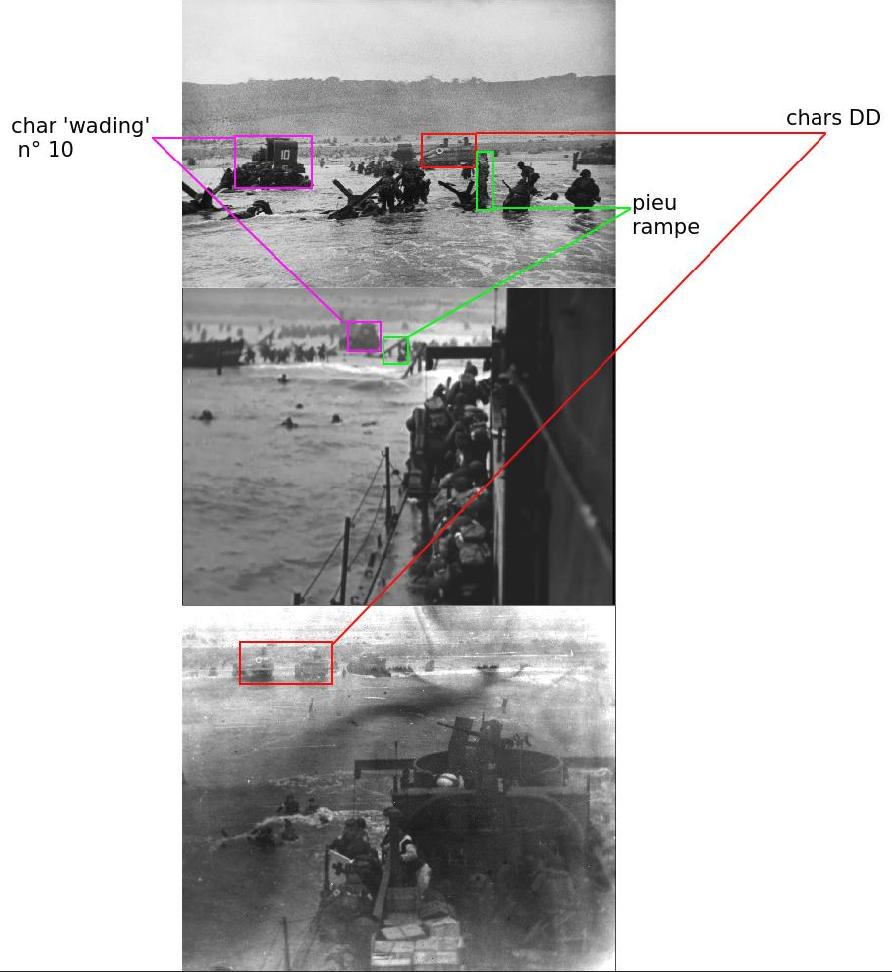
12 – From top to bottom: Robert Capa, photo C32; David T. Ruley, still from NARA film 428-NPC-15707, shot from LCI(L)-94; Gene R. Gislason, photo taken from the deck of the LCI(L)-94, The National WWII Museum, New Orleans. Annotated images.
•
In Ruley’s sequence, the layout of the obstacles and the “wading” tanks (including No. 10) is quite similar to that shown in Capa’s first five photos. While Capa’s photos were taken from the sea looking toward the shoreline, almost in line with the stake shown next to the hedgehog on the right, Ruley’s sequence was shot from an open angle that reveals the stake’s oblique support ramp. The difference in camera angle also explains why the two DD tanks near the shoreline, clearly visible in Capa’s photos, are not visible in Ruley’s sequence. They are, however, quite visible in the Gislason photo, taken (like the Ruley sequence) from LCI(L)-94, but from a lower level, closer to that of Capa’s shots.
The “wading” Sherman tank near the shore in Ruley’s clip, to the right of the two DD tanks, is also visible in Capa’s early shots, as well as in Gislason’s photo.
When Capa boarded LCI(L)-94 to leave Easy Red, he picked up his Rolleiflex after drying off. He then took some pictures from the deck of the ship. In one of them, also published in Life in its June 19, 1944 issue, one can clearly see the two DD tanks with their characteristic “chimneys” and the buoy on the left one.[1] The “wading” tanks are also recognizable (see detail, below right). Comparing the beach obstacles, one can also note that the tide is at a significantly higher level than in the previous documents.
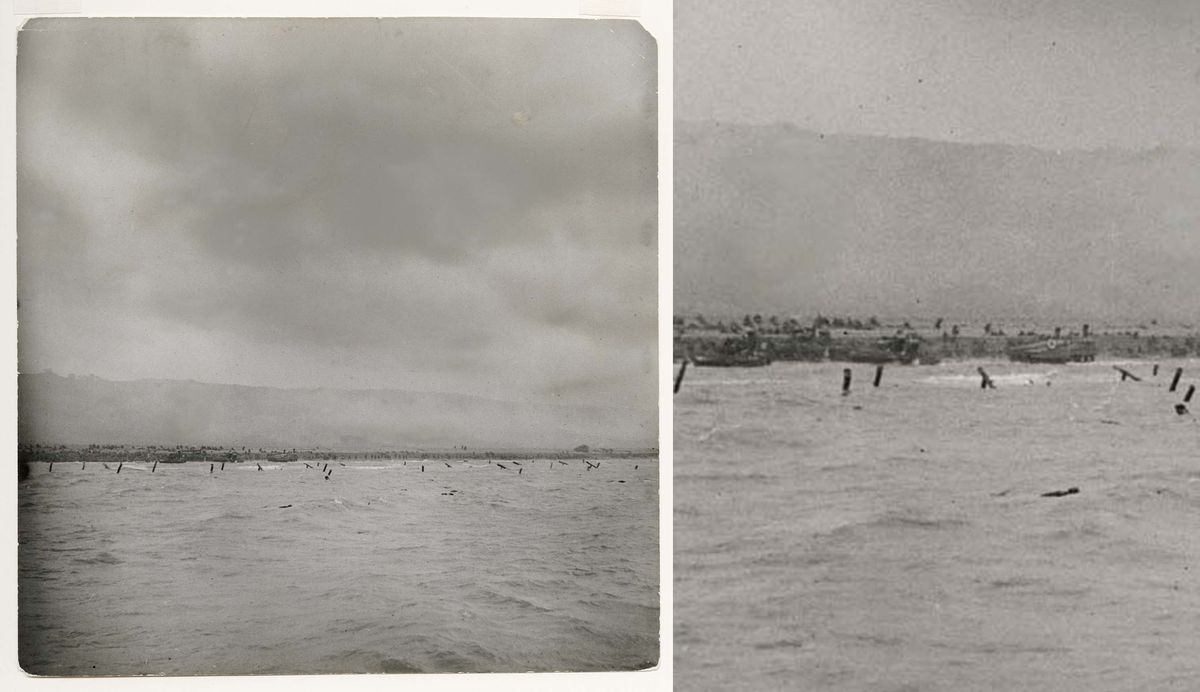
13 – Robert Capa, American soldiers landing on Omaha Beach, D-Day, Normandy, France, ICP website, screenshot. Photo published in Life, June 19, 1944, p. 28 / Detail of this photo.
•
Returning to the background visible in Ruley’s film, the DD tank seen advancing with a group of soldiers behind “wading” tank #10 does not appear in Capa’s and Gislason’s early photographs since it is outside their respective fields of vision.
In summary, the sources when compared clearly show the same area of Easy Red sector of Omaha Beach, captured from different angles and at slightly different times.
This correlation was demonstrated by A. D. Coleman and Charles Herrick as early as 2017 in the articles previously cited. (See especially: The Parallax View (#33) by A. D. Coleman, April 30, 2017; Guest Post 24: Charles Herrick on Capa’s D-Day (e), May 14, 2017; Guest Post 27: Charles Herrick on Capa’s D-Day (i), May 20, 2019.) Herrick even adds that the cross-reference can be continued with Capa’s subsequent photographs; thus, for example, he reconciles the obstacles that appear in “The Face in the Surf” (C37) photograph and those in Ruley’s film:
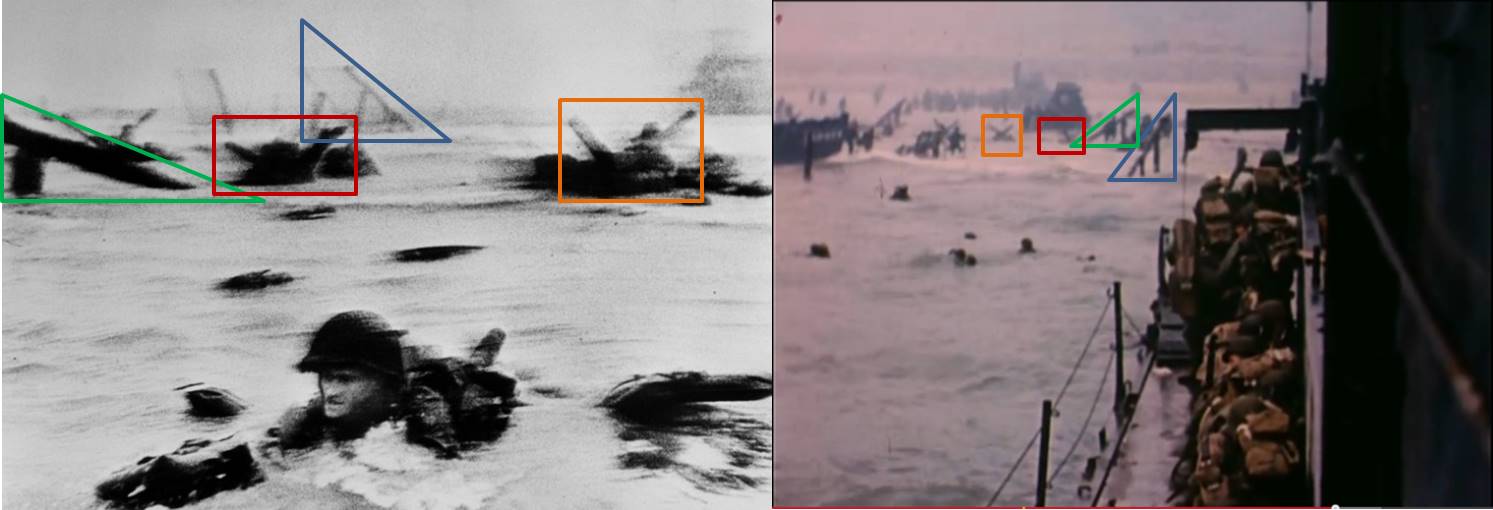
14 – Robert Capa, photo C37, “The Face in the Surf” (left); David Ruley, frame from D-Day film (right). Source : Guest Post 24: Charles Herrick on Capa’s D-Day (e), May 14, 2017, figure 4.
•
What is the chronology?
The relative chronology between the different sources — Capa, Ruley, and Gislason — is extremely difficult to establish.
The testimonies of the soldiers and sailors present on LCI(L)-94 got recorded long after the event, making their accuracy highly questionable. Capa’s account in his book Slightly Out of Focus is unreliable — remember that he was frank in admitting that his text was not always truthful.[2] The chronology can only be established by comparing the images with the supposed times of Capa’s landing and the two successive beachings of LCI(L)-94, which, as we know, did not follow the initial plan.
Despite these uncertainties, the level of the tide visible on the different images shows that the events captured took place in a relatively short period of time. According to Herrick, in fact, the tide at that time was rising about one foot every eleven minutes. Although the quality of Ruley’s film in the versions we have is very poor, it can be observed that the sea level that appears in the selected footage is quite similar to that in Capa’s photos, especially around the beach obstacles that provide a good landmark.
In the Gislason photos, the tide level appears higher. They were therefore taken later, certainly during the second beaching of the LCI. To confirm this, we have another clue. The Gislason photo already examined shows medical personnel disembarking using a gangway of the LCI, as well as a pile of boxes stored on the deck. However, after the sequence we have selected, Ruley’s film continues, and it includes another sequence where these stored crates appear identically arranged, with the same group of USCG sailors attending to them. Just before this sequence, beach obstacles are visible and once again the tide level appears higher. The Gislason photo and this second sequence were therefore taken at about the same time, and in all likelihood during the second beaching of the LCI.
On the other hand, in Slightly Out of Focus Capa also describes the arrival of an LCI under enemy fire and the “medics with red crosses painted on their helmets” disembarking; it is at this point that he starts running toward it, saying to himself, “I am just going to dry my hands on that boat.”[3] If we are to believe this account, his departure from the beach itself would therefore take place after the second beaching of LCI(L)-94.
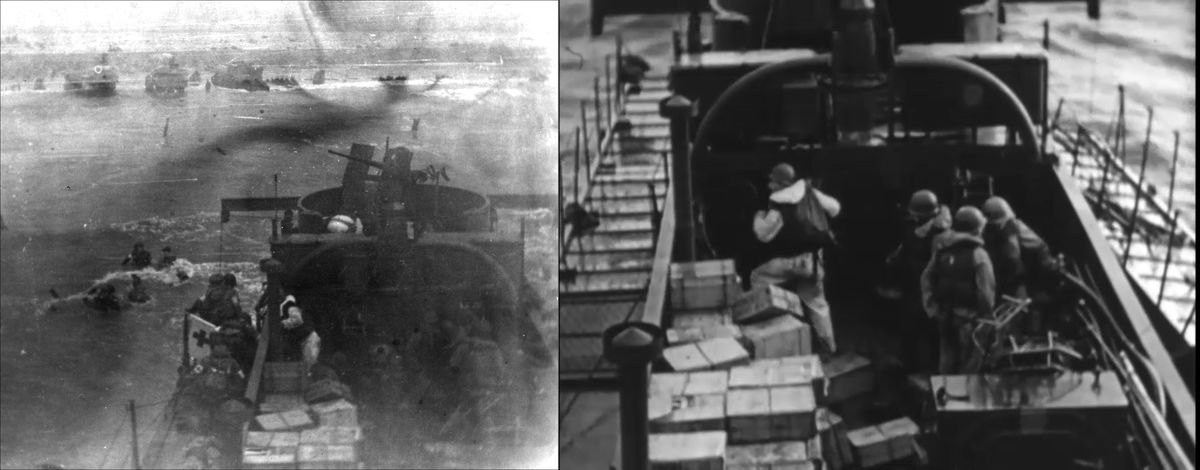
15 – Gene R. Gislason, photo taken from the bridge of LCI(L)-94, The National WWII Museum, New Orleans; David T. Ruley, frame from film NARA 428-NPC-15707, at timestamp 2:19.
•
In summary, the events photographed by Capa and Gislason and those filmed by Ruley took place in approximately the same place and in a reduced time span, on the order of thirty minutes. This lapse of time remains compatible with the duration of the maneuver carried out by Gislason for the two successive beachings of LCI(L)-94, about one hundred yards apart, and the two landings/unloadings which followed each of the beachings.
What timelines?
The discussion addressing the reconciliation of Capa’s photos with Ruley’s film did not result in agreement between the participants on the timing of the various events described. In order to assess the discrepancies between the options considered, which are on the whole minimal, the following is a list of the times selected according to the main sources.
Arrival of Capa on Easy Red sector
- Around 7:50-7:55 a.m., according to Villéger.
- Between 8:15 and 8:20, according to Herrick (September 23, 2015; schedule repeated several times in his articles).
- Between 8:15 and 8:20, according to Coleman (based on Herrick’s estimates).[4]
First grounding of LCI(L)-94
- Around 7:47 a.m., according to Villéger and Pieter Jutte.
- Estimated at about 8:25/8:30 by Herrick (May 14, 2017).
Second grounding of LCI(L)-94
- Estimated at 8:20/8:25 by Villéger (private conversations).
Shelling of LCI(L)-94
- 8:50 a.m., according to Herrick (May 14, 2017).
Boarding of Capa on LCI(L)-94
- Around 8:15 a.m., according to Pieter Jutte.
- 8:30-8:45, according to Coleman (based on Herrick’s estimates).[5]
- Capa was on board at 8:50, according to Herrick (May 14, 2019 and June 6, 2019).
Departure of LCI(L)-94 to the USS Samuel Chase
- 08:37 a.m., according to Villéger.
- 9:00, according to Herrick (May 14, 2017 and May 17, 2017).
- 9:00, according to Coleman (based on Herrick’s estimates).[6]
Two scenarios
Two main hypotheses have been formulated about the order and possible relationships between the events. We will call them here “uncorrelated scenario” and “correlated scenario.”
Uncorrelated scenario
The LCVP that appears in the background of Ruley’s film sequence is not the one that was carrying Capa. The soldiers in the first five photos of Capa are not the ones seen disembarking from the LCVP in the sequence. The photographer had arrived on the beach several minutes before LCI(L)-94 came ashore. Capa’s photos therefore predate the sequence filmed by Ruley.
This hypothesis is defended by Charles Herrick. According to Herrick, Capa landed on the Easy Red sector at about 8:20 a.m.[7] While he was taking his pictures, LCI(L)-94 approached the beach, ran aground for the first time, and began to land its troops. In support of this timeline, Herrick notices the shadow of a ship in the upper right corner of “The Face in the Surf.” He identifies this silhouette as LCI(L)-94 in its first grounding. For him, the ship in this photo was not moving away or taking up position for its second attempt at beaching; it was either arriving for its first beaching or had already stopped, and Capa, who was on the beach at the time, incidentally photographed it while taking his famous shot.
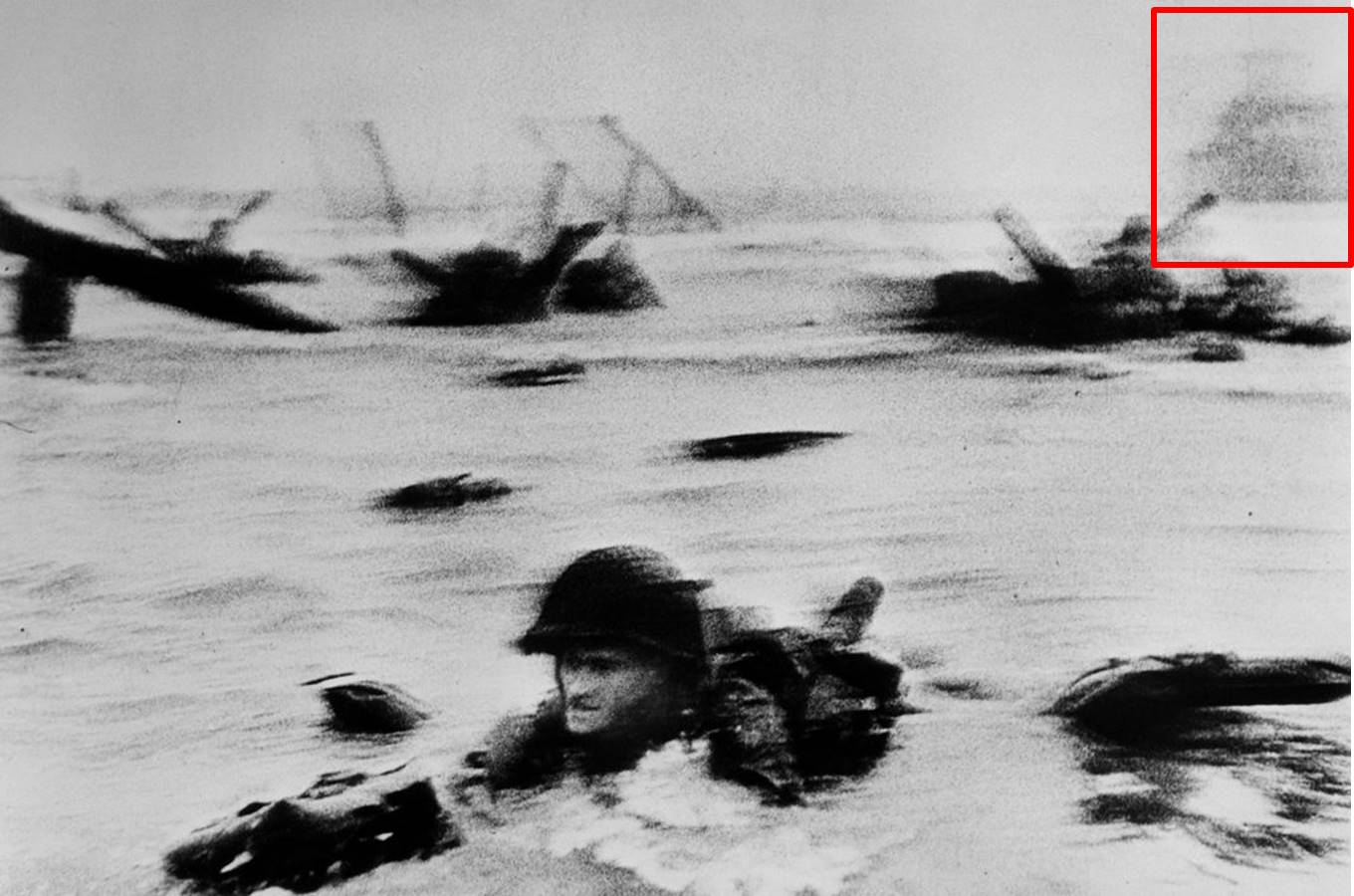
16 – Robert Capa, photo C37, The Face in the Surf, annotated by Charles Herrick. The silhouette of LCI(L)-94, aboard which Capa joined the USS Samuel Chase after Omaha Beach, appears in the red rectangle at upper right. Source: Guest Post 28: Charles Herrick on Capa’s D-Day (j), June 6, 2019.
•
Capa then boards LCI(L)-94 to leave the beach as the ship prepares to retire from its first grounding. The LCI moves away, then returns to ground a second time and finishes disembarking the medical personnel (see (15), above, for a comparison between the Gislason photo and the second Ruley sequence). LCI(L)-94 then left for the open sea and its return to the Chase.
According to Herrick, three other LCVPs were also scheduled to arrive on Easy Red within five minutes of the one carrying Capa; they carried command officers, medical personnel, and loads similar to those seen in the Ruley footage. Ultimately, Herrick believes that the LCVP in this footage was the one that carried the forward command post of the 1st Infantry Division (“The Big Red One”), which reached Easy Red shortly after Capa, following the same route.
Correlated scenario
The LCVP seen in the footage shot by Ruley is the one that carried Capa. The first five photos of Capa are therefore made a few seconds or minutes later than the film clip. The soldiers in these photos are the ones seen disembarking in the film. Since Capa was probably one of the last to leave the LCVP, if Ruley had filmed the scene a little longer, Capa could have been seen taking his first shots. This hypothesis was proposed by Philippe Villéger.
According to Villéger, this close connection is based on the individual identifications of several soldiers in both media. Villéger assumes that virtually every soldier in Capa’s early photographs can be matched to a soldier in the Ruley sequence. The identifications are rationalized by the men’s positions, their trajectories, and their relations to the other soldiers around them.
Here is an example of a match proposed by Villéger. Toward the end of the Ruley sequence, a soldier is seen falling. He is preceded by another soldier who is carrying a heavy load with his left arm [see the sequence filmed above in (5)].
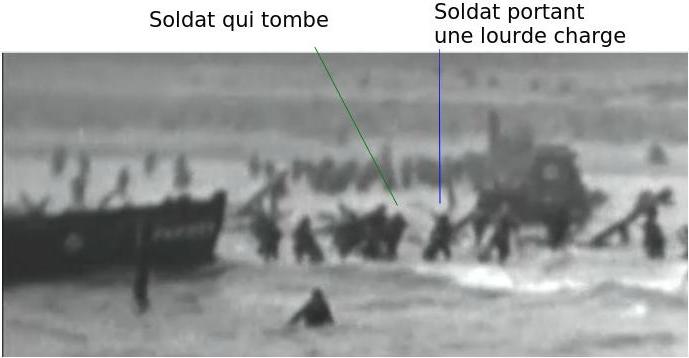
17 – David Ruley, sequence from NARA film 428-NPC-15707, annotated screenshot, detail, timestamp 0:09.
Villéger links these two men to two soldiers in Capa’s C31 photo.
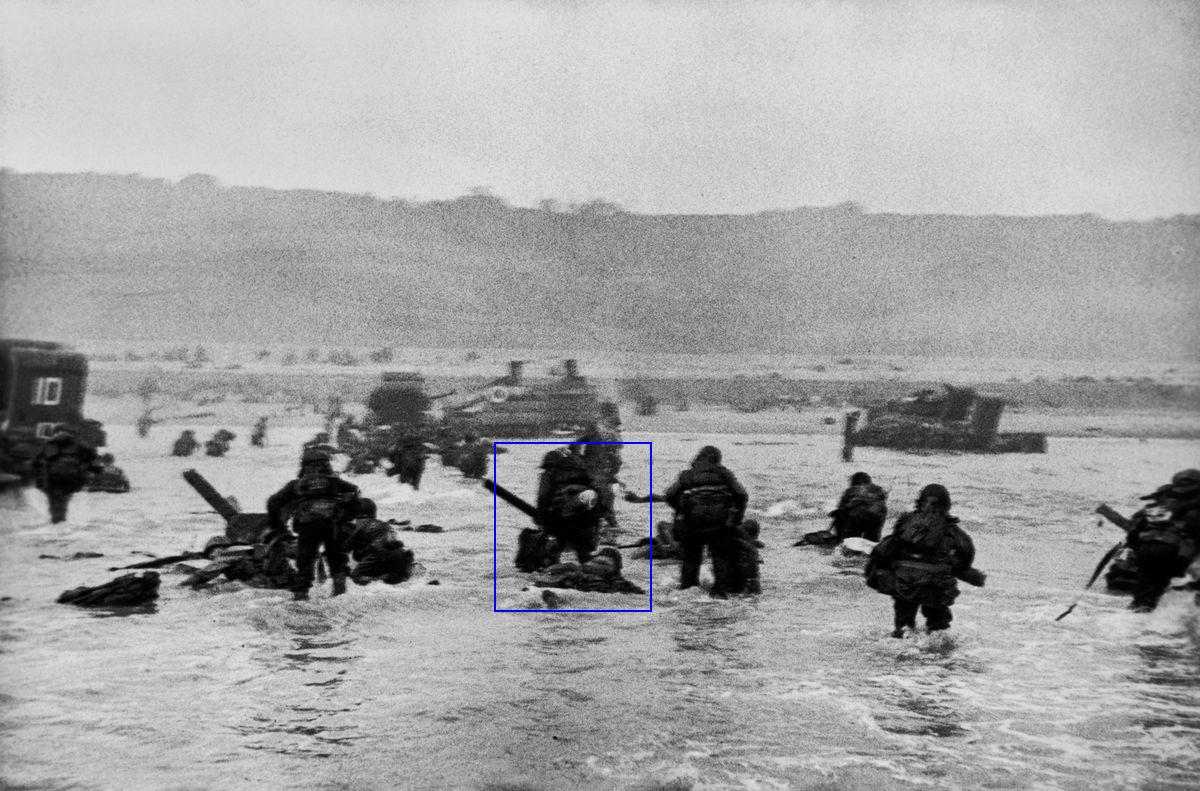
18 – Robert Capa, photo C31, annotated.
The soldier carrying a load is also visible in photos C32 and C33; his backpack has a characteristic light spot that can also be seen on the soldier who seems to correspond to him in the Ruley sequence.
According to this “correlated scenario,” LCI(L)-94 approaches the beach, beaches a first time, and starts to disembark troops. It is then that the LCVP which brings Capa in also disembarks its soldiers. The photographer then took his first shots facing toward the shore. After that he moved forward and took pictures facing towards the sea. In one of them, “The Face in the Surf,” the silhouette of the LCI is vaguely visible.
Meanwhile the LCI moves off, then returns to beach a second time, and its medical teams complete their disembarkation. It is then that Capa climbs aboard to leave the beach.
Divergence
The moment when Capa embarked on LCI(L)-94 to leave the beach constitutes the main point of divergence between the two versions.
Let’s go back to Capa’s account in his book.
He states that he boarded LCI(L)-94 just as the last of the medical personnel were coming ashore. Shortly afterwards, the LCI was hit by German shells. He says he went to the engine room to dry off. Then he went back up to the deck of the LCI, where he photographed the beach from a distance, shrouded in smoke, and the medical efforts to save the lives of the casualties of the shelling that had just occurred.[8] [See Charles Herrick’s analysis of recently discovered film by Ruley showing the damage caused by this shelling, published here after Peccatte published this article at his blog. — A.D.C.]
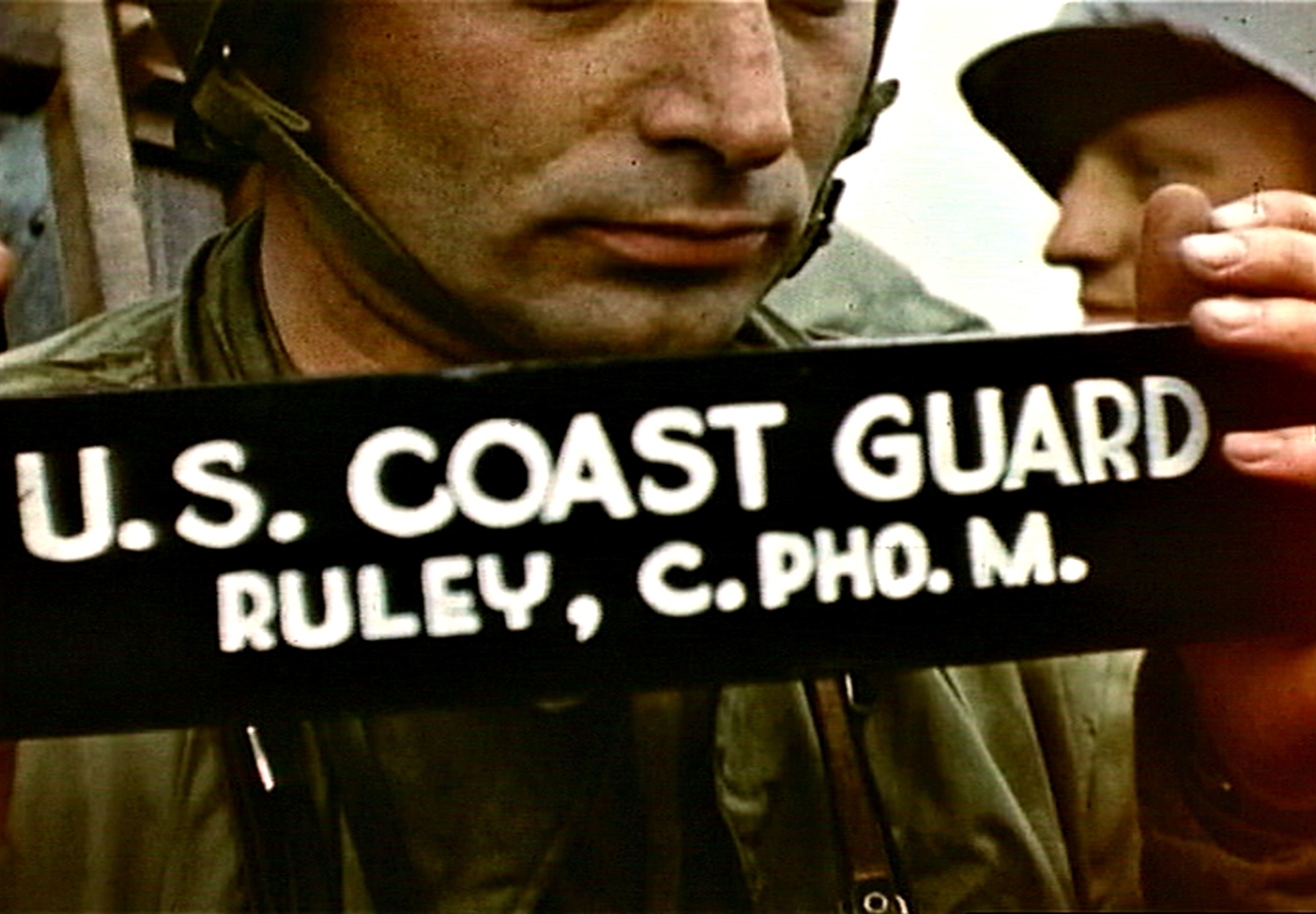
Robert Capa holding cinematographer’s slate aboard LCI(L)-94, D-Day, frame from film by David T. Ruley
As observed earlier, the final disembarkation of the LCI’s medical personnel is documented in one of Gislason’s photographs, as well as in a sequence in Ruley’s film (ref. 428-NPC-15707). It occurs during the second grounding of the LCI. In addition, footage from Ruley’s color film (ref. 428-NPC-10782) attests that Capa was indeed on board to hold Ruley’s slate, and to photograph the wounded and medics following this shelling. And in these images, he appears in a dry uniform. So he must have dried off in the engine room some time before taking his last photos.[9]
Villéger retained exactly this scenario for his hypothesis. Capa left the beach by boarding LCI(L)-94 during its second grounding. He quickly dried off and returned to the deck, where he held Ruley’s slate and took his last photos on board the LCI.
Let’s remember again that Capa’s book sometimes takes liberties with the truth. In particular, the account he gives of his return to the Chase is not particularly reliable, since he states that the ship he just boarded to leave the beach is taking on water and will sink. We know that this is not true. It was LCI(L)-85 that Capa saw sink, not LCI(L)-94 that he was on; the latter was damaged, but remained operational after repairs were carried out at the initiative of its commander, Gislason.
•
Would it be possible to remove some of the uncertainty about the scenarios and schedules described above? In order to make progress on the question of the timetable, we would have to discover new documents, especially the logbook of LCI(L)-94, which apparently no one has located yet. And in order to untangle the two scenarios, it is absolutely necessary to obtain a better-quality version of Ruley’s film, so as to resume the analysis of the correspondences between the soldiers in Capa’s first five images and those disembarking from the LCVP in Ruley’s clip, which are still very open to question.[10] …
•
Notes:
[1] See Alternate History: Robert Capa on D-Day (47), by A. D. Coleman, March 29, 2021, and photo 2430×2500 at the website of the International Center of Photography (ICP).
[2] “Writing the truth being so obviously difficult, I have in the interests of it allowed myself to go sometimes beyond and slightly this side of it. All events and persons in this book are accidental and have something to do with the truth.” Robert Capa, jacket blurb for the original edition of Slightly Out of Focus, quoted by Richard Whelan, in Robert Capa, op. cit., introduction, p. 13.
[3] Robert Capa, op. cit., pp. 171-172.
[4] A. D. Coleman, “Alternate History: Robert Capa on D-Day,” Exposure, February 12, 2019. This synopsis of his team’s research as of that date appeared in the journal of the U.S.-based Society for Photographic Education.
[5] A. D. Coleman, “Alternate History: Robert Capa on D-Day,” loc. cit.
[6] A. D. Coleman, “Alternate History: Robert Capa on D-Day,” loc. cit.
[7] For the argument in favor of this schedule, see the articles by Herrick already mentioned.
[8] Robert Capa, op. cit., pp. 171-172.
[9] See the Herrick articles previously mentioned, May 14, 2017 and May 17, 2017.
[10] As part of the PhotosNormandie project, we are currently looking for a better digitization of this film, and we are hopeful that this will succeed, thanks to the kindness of Dominique Forget from Archives de Guerres.
•
Patrick Peccatte is a former mathematics professor, computer engineer, and specialist in digital image databases. He was a research associate at the Laboratoire d’histoire visuelle contemporaine (Lhivic/EHESS). With Michel Le Querrec, he created and developed the PhotosNormandie project. He is currently an independent researcher and his research notebook Déjà Vu on visual studies is hosted on the academic platform Hypothèses.
His current research focuses on methodologies for the analysis of weakly structured iconographic sets, in particular images in popular culture.
•
PhotosNormandie is a French collaborative project that aims to improve the captions of more than 5100 photos and 300 historical films of the Normandy landings and battle. Active on the Flickr sharing platform since January 2007, it is one of the oldest crowdsourcing projects on images in the world. The PhotosNormandie team is made up of passionate amateurs and has also been interested in Robert Capa’s photos of the Battle of Normandy several times, although they do not belong to the project’s corpus (see the Robert Capa tag).
The photos of the project on Flickr:
https://www.flickr.com/photos/photosnormandie
The films of the project on YouTube:
https://www.youtube.com/user/PhotosNormandie/videos
The FAQ of the project, in French:
https://dejavu.hypotheses.org/2998
•
Philippe Villéger is a contributor to the PhotosNormandie project. It is within the framework of the project that he formulated the hypothesis discussed in this article. He works in a company that manufactures small series of mechanical parts, mainly for the aeronautical industry.






Leave a Comment